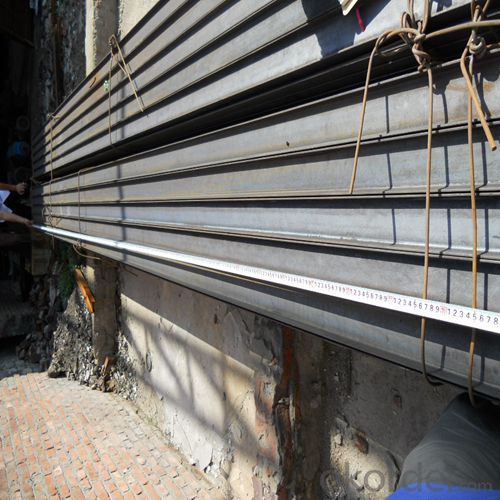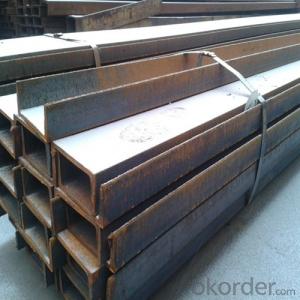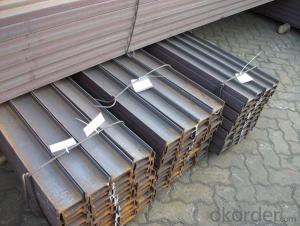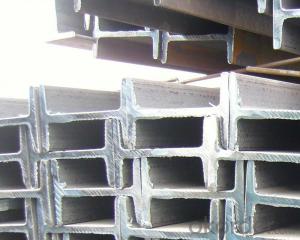Hot Rolled Steel I-Beam IPE IPEAA EN10025 S235JR
- Loading Port:
- Tianjin
- Payment Terms:
- TT or LC
- Min Order Qty:
- 50 m.t.
- Supply Capability:
- 30000 m.t./month
OKorder Service Pledge
OKorder Financial Service
You Might Also Like
Product Description:
OKorder is offeringHot Rolled Steel I-Beam IPE IPEAA EN10025 S235JR at great prices with worldwide shipping. Our supplier is a world-class manufacturer of steel, with our products utilized the world over. OKorder annually supplies products to European, North American and Asian markets. We provide quotations within 24 hours of receiving an inquiry and guarantee competitive prices.
Product Applications:
Hot Rolled Steel I-Beam IPE IPEAA EN10025 S235JR are ideal for structural applications and are widely used in the construction of buildings and bridges, and the manufacturing, petrochemical, and transportation industries.
Product Advantages:
OKorder's Hot Rolled Steel I-Beam IPE IPEAA EN10025 S235JR are durable, strong, and resist corrosion.
Main Product Features:
· Premium quality
· Prompt delivery & seaworthy packing (30 days after receiving deposit)
· Corrosion resistance
· Can be recycled and reused
· Mill test certification
· Professional Service
· Competitive pricing
Product Specifications:
Usage & Applications of Hot Rolled Steel H-beam For Sale
Commercial building structure ;Pre-engineered buildings; Machinery support structure; Prefabricated structure; Medium scale bridges; Ship-building structure.etc.
Packaging & Delivery of Hot Rolled Steel H-beam For Sale
1. Packing: it is nude packed in bundles by steel wire rod
2. Bundle weight: not more than 3.5MT for bulk vessel; less than 3 MT for container load
3. Marks:
Color marking: There will be color marking on both end of the bundle for the cargo delivered by bulk vessel. That makes it easily to distinguish at the destination port.
Tag mark: there will be tag mark tied up on the bundles. The information usually including supplier logo and name, product name, made in China, shipping marks and other information request by the customer.
If loading by container the marking is not needed, but we will prepare it as customer request.
4. Transportation: the goods are delivered by truck from mill to loading port, the maximum quantity can be loaded is around 40MTs by each truck. If the order quantity cannot reach the full truck loaded, the transportation cost per ton will be little higher than full load.
5. Delivered by container or bulk vessel
FAQ:
Q1: Why buy Materials & Equipment from OKorder.com?
A1: All products offered byOKorder.com are carefully selected from China's most reliable manufacturing enterprises. Through its ISO certifications, OKorder.com adheres to the highest standards and a commitment to supply chain safety and customer satisfaction.
Q2: How do we guarantee the quality of our products?
A2: We have established an advanced quality management system which conducts strict quality tests at every step, from raw materials to the final product. At the same time, we provide extensive follow-up service assurances as required.
Q3: How soon can we receive the product after purchase?
A3: Within three days of placing an order, we will begin production. The specific shipping date is dependent upon international and government factors, but is typically 7 to 10 workdays.
Q4: What makes stainless steel stainless?
A4: Stainless steel must contain at least 10.5 % chromium. It is this element that reacts with the oxygen in the air to form a complex chrome-oxide surface layer that is invisible but strong enough to prevent further oxygen from "staining" (rusting) the surface. Higher levels of chromium and the addition of other alloying elements such as nickel and molybdenum enhance this surface layer and improve the corrosion resistance of the stainless material.
Q5: Can stainless steel rust?
A5: Stainless does not "rust" as you think of regular steel rusting with a red oxide on the surface that flakes off. If you see red rust it is probably due to some iron particles that have contaminated the surface of the stainless steel and it is these iron particles that are rusting. Look at the source of the rusting and see if you can remove it from the surface.
Images:


- Q: Can steel I-beams be bolted together?
- Yes, steel I-beams can be bolted together.
- Q: Are steel I-beams suitable for high-rise building construction?
- Steel I-beams are an excellent choice for constructing high-rise buildings. They have been widely used in the construction industry for many years because of their numerous advantages. To begin with, steel I-beams have a remarkable strength-to-weight ratio, which makes them perfect for tall structures. They can support heavy loads and provide exceptional structural support, which is vital for high-rise buildings. This strength allows for the construction of taller and more spacious buildings without compromising their structural integrity. Furthermore, steel I-beams are extremely durable and resistant to various environmental factors. They can withstand extreme weather conditions, seismic activities, and even fires. This durability ensures the longevity and safety of high-rise buildings, providing a secure living or working environment for occupants. In addition, steel I-beams are versatile and allow for flexible design options. They can be customized to meet specific architectural requirements and building codes. This flexibility enables architects and engineers to create innovative and aesthetically pleasing high-rise structures. Moreover, the use of steel I-beams in high-rise construction allows for faster and more efficient construction processes. Steel is readily available, and the prefabricated nature of I-beams makes them easy to transport and assemble on-site. This reduces construction time and costs, making it an attractive option for building owners. Lastly, steel I-beams are sustainable and environmentally friendly. Steel is a highly recyclable material, and using it in construction helps reduce the demand for new raw materials. Additionally, steel structures can be dismantled and recycled at the end of their lifespan, minimizing waste and environmental impact. In conclusion, steel I-beams are highly suitable for high-rise building construction due to their exceptional strength, durability, versatility, efficiency, and sustainability. They have proven to be a reliable and cost-effective choice for creating tall and safe structures, making them a preferred option in the construction industry.
- Q: What are the standard lengths of steel I-beams?
- The standard lengths of steel I-beams vary depending on the specific type and manufacturer. However, common lengths range from 20 feet to 60 feet, with increments of 10 feet.
- Q: How do steel I-beams compare to other types of structural beams?
- Steel I-beams are widely considered to be one of the strongest and most durable options among structural beams. They offer superior load-bearing capacity, excellent resistance to bending or warping, and can span longer distances without the need for additional support compared to other types of beams. Additionally, steel I-beams are versatile, easy to fabricate, and have a high strength-to-weight ratio, making them a popular choice in various construction applications.
- Q: What is the cost of steel I-beams compared to other structural materials?
- The cost of steel I-beams compared to other structural materials can vary depending on several factors. Generally, steel I-beams tend to be more expensive than materials like wood or concrete. However, when compared to other steel structural materials, such as steel tubes or columns, I-beams may be more cost-effective. The price of steel I-beams is influenced by various factors, including the size and weight of the beam, the grade of steel used, and market conditions. Larger and heavier I-beams will generally have a higher cost, as they require more raw materials and production processes. The grade of steel used can also affect the price, with higher-grade steels typically commanding a higher cost due to their enhanced strength and durability. Moreover, market conditions play a significant role in determining the cost of steel I-beams. Fluctuations in the availability and demand for steel can impact the price. For instance, during periods of high demand or shortages, the cost of steel I-beams may increase. On the other hand, during periods of low demand or oversupply, prices may be more competitive. It is important to consider that while steel I-beams may have a higher upfront cost compared to other materials, they offer numerous advantages that make them a preferred choice for many construction projects. Steel I-beams are known for their exceptional strength-to-weight ratio, durability, and versatility. They can withstand heavy loads, provide long-term structural integrity, and require minimal maintenance. These benefits often offset the initial cost and make steel I-beams a cost-effective choice in the long run. Ultimately, the cost of steel I-beams compared to other structural materials will depend on various factors, including size, grade, market conditions, and the specific needs of the project. It is advisable to consult with a construction professional or supplier to obtain accurate and up-to-date pricing information for a specific application.
- Q: Can steel I-beams be used for healthcare facilities?
- Yes, steel I-beams can be used for healthcare facilities. Steel I-beams are commonly used in construction for their strength and durability, making them suitable for a variety of applications including healthcare facilities. These beams provide structural support and can be used for framing walls, floors, and roofs, ensuring the stability and integrity of the building. Additionally, steel I-beams are fire-resistant, which is crucial for healthcare facilities where safety is of utmost importance. Furthermore, steel is a sustainable and recyclable material, aligning with the growing green building practices in the healthcare industry. Overall, steel I-beams are a reliable and practical choice for constructing healthcare facilities.
- Q: Can steel I-beams be used in both residential and commercial buildings?
- Yes, steel I-beams can be used in both residential and commercial buildings. Steel I-beams are commonly used as structural supports due to their strength, durability, and versatility. They provide excellent load-bearing capabilities, allowing for the construction of large spans and open floor plans. In residential buildings, steel I-beams are often used to support the weight of upper floors and roof structures. In commercial buildings, they are frequently employed in the construction of warehouses, factories, and high-rise buildings. The use of steel I-beams ensures the structural integrity of the building, making them suitable for various applications in both residential and commercial settings.
- Q: What are the different grades of steel used in manufacturing I-beams?
- There are several different grades of steel commonly used in the manufacturing of I-beams. These grades include A36, A572, A992, and A588. A36 steel is the most commonly used grade for I-beams due to its strength and versatility. It has a minimum yield strength of 36,000 psi and a minimum tensile strength of 58,000-80,000 psi. A36 steel is often used in construction and structural applications. A572 steel is another popular grade for I-beams, particularly in the construction industry. It has a minimum yield strength of 50,000 psi and a minimum tensile strength of 65,000-85,000 psi. A572 steel is known for its high strength and excellent weldability. A992 steel is a relatively new grade that has become increasingly popular in recent years. It has a minimum yield strength of 50,000 psi and a minimum tensile strength of 65,000-85,000 psi. A992 steel offers improved strength and durability compared to A36 and A572, making it suitable for a wide range of applications. A588 steel is a high-strength, low-alloy grade commonly used in structural applications such as bridges and buildings. It has a minimum yield strength of 50,000 psi and a minimum tensile strength of 70,000-95,000 psi. A588 steel is known for its corrosion resistance and can withstand harsh environmental conditions. Overall, the choice of steel grade for manufacturing I-beams depends on the specific requirements of the project, including strength, durability, and corrosion resistance.
- Q: How do steel I-beams perform in areas with high UV exposure?
- In areas with high UV exposure, steel I-beams excel due to their protective coatings. These coatings, such as galvanized or painted finishes, are specially formulated to withstand the harmful effects of UV rays. By acting as a barrier, they prevent direct sun exposure to the steel's ultraviolet radiation. While materials can degrade and discolor over time from UV exposure, steel I-beams are highly resistant to these effects. The protective coatings not only shield the steel from UV rays but also offer additional corrosion resistance, ultimately extending the lifespan of the beams. Nevertheless, it is crucial to acknowledge that even the most durable coatings may experience some level of degradation over an extended period. Therefore, regular inspections and maintenance are essential to ensure the continued performance of steel I-beams in areas with high UV exposure. This may entail periodically reapplying protective coatings or following other maintenance procedures recommended by the manufacturer.
- Q: Can steel I-beams be used in curved or sloped designs?
- Yes, steel I-beams can be used in curved or sloped designs. While I-beams are typically used in straight construction applications, they can also be utilized in curved or sloped designs with certain modifications and techniques. One method is to cut the I-beam into smaller sections and then weld or bolt them together to create the desired curved or sloped shape. This process may require additional engineering considerations to ensure the structural integrity of the beams. Alternatively, custom-shaped I-beams can be manufactured specifically for curved or sloped designs. These custom beams are fabricated by bending or rolling the steel to the desired shape. However, it is important to note that curved or sloped designs using steel I-beams may require more complex calculations and engineering expertise to ensure the structural stability and safety of the construction. Therefore, it is recommended to consult with a structural engineer or a professional in the field when considering the use of steel I-beams in curved or sloped designs.
Send your message to us
Hot Rolled Steel I-Beam IPE IPEAA EN10025 S235JR
- Loading Port:
- Tianjin
- Payment Terms:
- TT or LC
- Min Order Qty:
- 50 m.t.
- Supply Capability:
- 30000 m.t./month
OKorder Service Pledge
OKorder Financial Service
Similar products
Hot products
Hot Searches
Related keywords




























